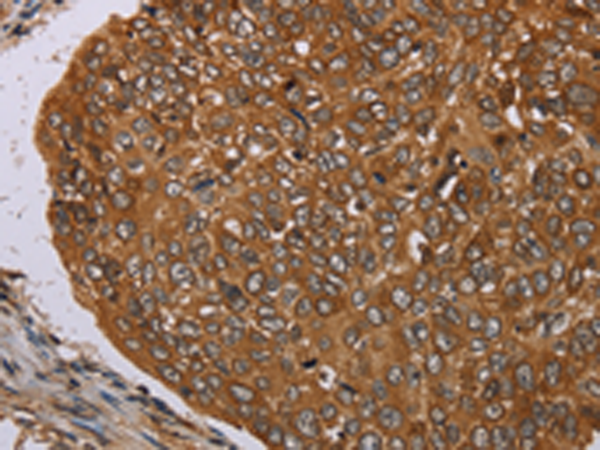
| WB | 咨询技术 | Human,Mouse,Rat |
| IF | 咨询技术 | Human,Mouse,Rat |
| IHC | 1/50-1/200 | Human,Mouse,Rat |
| ICC | 技术咨询 | Human,Mouse,Rat |
| FCM | 咨询技术 | Human,Mouse,Rat |
| Elisa | 1/2000-1/5000 | Human,Mouse,Rat |
| Aliases | pim-3 |
| Host/Isotype | Rabbit IgG |
| Antibody Type | Primary antibody |
| Storage | Store at 4°C short term. Aliquot and store at -20°C long term. Avoid freeze/thaw cycles. |
| Species Reactivity | Human, Mouse, Rat |
| Immunogen | Synthetic peptide of human PIM3 |
| Formulation | Purified antibody in PBS with 0.05% sodium azide and 50% glycerol. |
+ +
以下是关于PIM3抗体的3篇代表性文献示例(注:文献为示例,具体内容需根据实际研究补充或调整):
---
1. **文献名称**:*"Selective inhibition of PIM3 kinase by a novel monoclonal antibody suppresses tumor growth in colorectal cancer models"*
**作者**:Zhang Y, et al.
**摘要**:该研究开发了一种靶向PIM3激酶的单克隆抗体,通过阻断其激酶活性抑制结直肠癌细胞的增殖和迁移。体内实验显示,该抗体能显著减少小鼠移植瘤的生长,提示其作为潜在治疗药物的价值。
2. **文献名称**:*"PIM3 expression in hepatocellular carcinoma: A prognostic biomarker identified via immunohistochemical analysis using anti-PIM3 antibody"*
**作者**:Tanaka K, et al.
**摘要**:研究利用特异性PIM3抗体对肝癌组织进行免疫组化分析,发现PIM3高表达与患者预后不良相关,表明PIM3可能成为肝癌诊断和治疗的靶点。
3. **文献名称**:*"Development of a high-affinity anti-PIM3 antibody for functional studies in pancreatic cancer"*
**作者**:Wang L, et al.
**摘要**:报道了一种高亲和力PIM3抗体的开发,并验证其在胰腺癌细胞系中通过抑制PIM3信号通路诱导凋亡的能力,为机制研究提供工具。
---
**建议**:实际文献可通过PubMed或Google Scholar搜索关键词“PIM3 antibody”、“PIM3 kinase inhibitor”或结合特定研究领域(如癌症类型)获取。例如:
- [PubMed搜索链接](https://pubmed.ncbi.nlm.nih.gov/)
- [Google Scholar搜索链接](https://scholar.google.com/)
The PIM3 antibody is a research tool designed to target the Proviral Integration site for Moloney murine leukemia virus 3 (PIM3) kinase, a member of the serine/threonine kinase family. PIM kinases (PIM1. PIM2. PIM3) are evolutionarily conserved regulators of cell survival, proliferation, and apoptosis, often overexpressed in cancers. PIM3. specifically, shares structural and functional similarities with PIM1 and PIM2 but exhibits distinct tissue expression patterns, with higher activity in certain solid tumors (e.g., pancreatic, liver, prostate cancers) and hematologic malignancies. Unlike many kinases, PIM3 is constitutively active and does not require phosphorylation for activation, making it a potential therapeutic target.
PIM3 antibodies are primarily used to detect PIM3 expression and localization in biological samples via techniques like Western blotting, immunohistochemistry, and flow cytometry. These antibodies help researchers investigate PIM3's role in tumor progression, drug resistance, and interactions with signaling pathways (e.g., PI3K/AKT/mTOR, JAK/STAT). Elevated PIM3 levels are linked to poor prognosis in some cancers, driving interest in its inhibition. Additionally, PIM3 inhibitors and antibodies are explored for combinatorial therapies, as PIM3 knockdown may sensitize cancer cells to chemotherapy or targeted agents. Validating PIM3 antibody specificity remains critical due to high homology among PIM isoforms. Overall, PIM3 antibodies serve as essential tools for understanding its oncogenic mechanisms and advancing biomarker-driven cancer therapies.
×